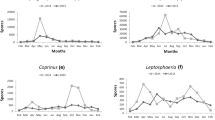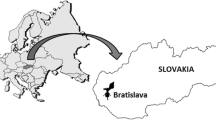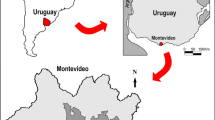Abstract
Even though the presence of Curvularia conidia in the tropical air and the role in respiratory allergy symptoms or plant diseases incidence has been reported, traditional aerobiological investigations usually do not consider their profound study. An aeromycological study of the Curvularia propagules in Havana was conducted during the years 2017 and 2018. Monitoring was carried out by means of volumetric viable and non-viable methodologies. Three types of microscopically identifiable airborne spores (Lunata, Geniculata and Maculans) were identified, according to their distinctive features (conidium shape, pigmentation, number and position of the septa), defined by optical microscopy with 400 × magnification. The spores of Curvularia showed prevalence during rainy months and were predominantly abundant through the daytime. The annual distribution showed the prevalence of the Lunata type, with a diurnal pattern and corroborated through the isolated species since all belonged to this morphological group. The average temperature and relative humidity, as well as the precipitations, correlated positively with the concentrations. The wind speed showed a negative correlation, which indicates that the climatic conditions of the Havana influence the aerobiological dynamics of airborne Curvularia propagules.





Similar content being viewed by others
References
Agarwal, M. K., Jones, R. T., & Yunginger, J. W. (1982). Shared allergenic and antigenic determinants in Alternaria and Stemphylium extracts. J Allergy Clini Immunol, 70, 437–444.
Agashe, S. N., & Anand, P. (1982). Immediate type hypersensitivity to common pollen and molds in Bangalore city. Aspects Allergy Appl Immunol, 15, 49–52.
Aira, M. J., Rodríguez-Rajo, F. J., Castro, M., & Jato, V. (2009). Characterization of Coprinus spores in the NW of the Iberian Peninsula Identification and count in aerobiological samples. Cryptogamie. Mycologie, 30(1), 57–66.
Aira, M. J., Rodríguez-Rajo, F. J., Fernández-González, M., Seijo, C., Elvira-Rendueles, B., Abreu, I., & Tormo, R. (2013). Spatial and temporal distribution of Alternaria spores in the Iberian Peninsula atmosphere and meteorological relationships. International Journal of Biometeorology, 57(2), 265–274. https://doi.org/10.1007/s00484-012-0550-x
Aira, M. J., Rodríguez-Rajo, F. J., Fernández-González, M., Seijo, C., Elvira-Rendueles, B., Gutiérrez-Bustillo, M., et al. (2012). Cladosporium airborne spore incidence in the environmental quality of the Iberian Peninsula. Grana, 51(4), 293–304. https://doi.org/10.1080/00173134.2012.717636
Almaguer, M., Aira, M. J., Rodríguez-Rajo, F. J., & Rojas, T. I. (2013). Study of airborne fungus spores by viable and non-viable methods in Havana. Cuba. Grana, 52(4), 289–298. https://doi.org/10.1080/00173134.2013.829869
Almaguer, M., Aira, M. J., Rodríguez-Rajo, F. J., & Rojas, T. I. (2015). Thirty four identifiable airborne fungal spores at Havana. Cuba. Annals Agric Environ Med, 22(2), 220–225. https://doi.org/10.5604/12321966.1152068
Almaguer, M., & Rojas, T. I. (2013). Aeromicota viable de la atmósfera de La Habana Cuba. Nova Acta Científica Compostelana, 20, 35–45.
Almaguer, M., Rojas, T. I., Rodríguez-Rajo, F. J., & Aira, M. J. (2012). Airborne fungal succession in a rice field of Cuba. European Journal of Plant Pathology, 133(2), 473–482. https://doi.org/10.1007/s10658-011-9921-0
Álvarez, M., Castro, R., Leyva, Y., Lopez, B., Rodríguez, J., Rojas, T., Piera, O., & Labrada, A. (2020). Sensibilización a hongos anemófilos en trabajadores del Archivo y Biblioteca de la Universidad de La Habana. Archivos del Hospital Universitario "General Calixto García", 8(2), 159–172.
Ariyawansa, H. A., Thambugala, K. M., Manamgoda, D. S., Jayawardena, R., Camporesi, E., Boonmee, S., et al. (2015). Towards a natural classification and backbone tree for Pleosporaceae. Fung Divers, 71, 85–139. https://doi.org/10.1007/s13225-015-0323-z
Arnold, G. R., Guerra, A. G., & Rodríguez de La Rosa, N. (1987). Presencia de hongos del aire del INIFAT. Reporte de Investigación del Instituto de Investigaciones Fundamentales en Agricultura Tropical, 43, 1–6.
Arora, A., & Jain, V. K. (2003). Fungal air spora of Bikaner. Indian j aerobiol, 16(1), 1–9.
Barrios, O. H., Rodríguez, I. P., Heredia, L. O., Torres, N. R., Vidal, L. G., Ayala, Y. M., & Luna, L. L. (2019). Sensibilidad cutánea a hongos ambientales y estudio de la micobiota nasal de pacientes con alergias respiratoria. Investigaciones Medicoquirúrgicas, 11(2), 1–10.
Boedijn, K. B. (1933). Über einige phragmosporen Dematiazen. Bulletin du Jardin Botanique de Buitenzorg, 13, 120–134.
Camino M, Mena J, Minter D (2006) Fungi of Cuba. www.cybertruffle.org.uk/cubafung
Chen, B., Jasmine, C., Wu, C., Kim, H., Honda, Y., & Leon, Y. (2014). High ambient Cladosporium spores were associated with reduced lung function in schoolchildren in a longitudinal study. Science of the Total Environment, 481, 370–376. https://doi.org/10.1016/j.scitotenv.2014.01.078
Chew, F. T., Lim, S. H., Shang, H. S., Dahlia, D. S., Goh, D. Y. T., Lee, B. W., et al. (2000). Evaluation of the allergenicity of tropical pollen and airborne spores in Singapore. Allergy, 55, 340–347. https://doi.org/10.1034/j.1398-9995.2000.00308.x
Codina, R., Fox, R. W., Lockey, R. F., De Marco, P., & Bagg, A. (2008). Typical levels of airborne fungal spores in houses without obvious moisture problems during a rainy season in Florida. J Invest Allergol Clin Immunol, 18, 156–162.
Da Cunha K (2014) Phenotypic and molecular characterization of clinical isolates of bipolaris, curvularia, exserohilum and pithomyces (Doctoral dissertation, Universitat Rovira i Virgili). https://www.tdx.cat/handle/10803/279271#page=1
Dey, D., Ghosa, K., & Bhattacharya, S. G. (2019). Aerial fungal spectrum of Kolkata. India. along with their allergenic impact on the public health: a quantitative and qualitative evaluation. Aerobiologia, 35(1), 15–25. https://doi.org/10.1007/s10453-018-9534-6
Dransfield, M. (1966). The fungal air spora at Samaru, northern Nigeria. Trans British Mycol Soc, 41(1), 121–132.
Ellis, M. B. (1971). Dematiaceous Hyphomycetes. CMI: Commonwealth Mycological Institute. Kew. Survey. England.
Ellis, M. B. (1976). More Dematiaceous Hyphomycetes. England: Commonwealth Mycological Institute. Kew.
Esch, R. E., & Codina, R. (2017). Fungal raw materials used to produce allergen extracts. Annals Allergy, Asthma Immunol, 118(4), 399–405. https://doi.org/10.1016/j.anai.2016.05.012
Estrada, G., & Sandoval, I. (2004). Patogenicidad de especies de Curvularia en arroz. Fitosanidad, 8(4), 23–26.
Fernández-Rodríguez, S., Tormo-Molina, R., Maya-Manzano, J. M., Silva-Palacios, I., & Gonzalo-Garijo, Á. (2014). Outdoor airborne fungi captured by viable and non-viable methods. Fungal Ecol, 7, 16–26. https://doi.org/10.1016/j.funeco.2013.11.004
Galán, C., González, P. C., Teno, P. A., & Vilches, E. D. (2007). Manual de Calidad y Gestión de la Red Española de Aerobiología. España: Servicio de Publicaciones. Universidad de Córdoba.
Grant, E. (1990). Sampling and identifying allergenic pollens and molds. USA: Blewstone Press. San Antonio.
Gregory, P. H. (1978). Distribution of airborne pollen and spores and their long distance transport. Pure and Applied Geophysics, 116(2–3), 309–315.
Gupta, R., Singh, B. P., Sridhara, S., Gaur, S. N., Kumar, R., Chaudhary, V. K., & Arora, N. (2002). Allergenic cross-reactivity of Curvularia lunata with other airborne fungal species. Allergy, 57, 636–640. https://doi.org/10.1034/j.1398-9995.2002.03331.x
Haines, J., Escamilla, B., Muilenberg, M., Gallup, J., & Levetin, E. (1999). Mycology of the air: a workshop manual for sampling and identifying airborne fungus spores. New York State Museum, New York: Pan-American Aerobiology Association Tucson AZ.
Hernández Trejo, F. H., Rodríguez, A. F. M., Molina, R. T., & Palacios, I. S. (2012). Airborne ascospores in Mérida (SW Spain) and the effect of rain and other meteorological parameters on their concentration. Aerobiologia, 28(1), 13–26. https://doi.org/10.1007/s10453-011-9207-1
Hirst, J. M. (1952). An automatic volumetric spore trap. Annals Appl Biol, 39(2), 257–265.
Hughes, S. J. (1979). Fungi Can., 150, 1–2.
Hyde, K. D., Norphanphoun, C., Abreu, V. P., et al. (2017). Fungal diversity notes 603–708: taxonomic and phylogenetic notes on genera and species. Fungal Divers, 87, 1–235. https://doi.org/10.1007/s13225-017-0391-3
Ingold, C. T. (1965). Spore liberation. Oxford: Clarendon Press, Oxford.
Kakde, U., & Kakde, H. (2012). Incidence of post-harvest disease and airborne fungal spores in a vegetable market. Acta Botanica Croatica, 71(1), 147–157.
Lacey, J. (1981). The aerobiology of conidial fungi. In G. T. Cole & B. Kendrick (Eds.), Biology of conidial fungi (pp. 373–416). New York: Academic Press, INC.
LarenasLinnemann, D., Baxi, S., Phipatanakul, W., Portnoy, J. M., Barnes, C., Grimes, C., & Scott, J. (2016). Clinical evaluation and management of patients with suspected fungus sensitivity. J Allergy Clin Immunol Pract, 4(3), 405–414. https://doi.org/10.1016/j.jaip.2015.10.015
Levetin, E., Horner, W. E., Scott, J. A., & Workgroup, E. A. (2016). Taxonomy of allergenic fungi. J Allergy Clin Immunol In Pract, 4(3), 375–385.
Madrid, H., da Cunha, K. C., Gené, J., Dijksterhuis, J., Cano, J., Sutton, D. A., et al. (2014). Novel Curvularia species from clinical specimens. Persoonia, 33, 48–60.
Manamgoda, D. S., Cai, L., McKenzie, E. H. C., Crous, P. W., Madrid, H., Chukeatirote, E., et al. (2012). A phylogenetic and taxonomic re-evaluation of the Bipolaris-Cochliobolus-Curvularia complex. Fungal Divers, 56, 131–144. https://doi.org/10.1007/s13225-012-0189-2
Manamgoda, D. S., Rossman, A. Y., Castlebury, L. A., Chukeatirote, E., & Hyde, K. D. (2015). A taxonomic and phylogenetic re-appraisal of the genus Curvularia (Pleosporaceae) human and plant pathogens. Phytotaxa, 212(3), 175–198.
Marin-Felix, Y., Groenewald, J. Z., Cai, L., Chen, Q., Marincowitz, S., Barnes, I., et al. (2017). Genera of phytopathogenic fungi: GOPHY 1. Studies in Mycology, 86, 99–216. https://doi.org/10.1016/j.simyco.2017.04.002
Martínez, B., Pérez, S., & Plana, R. (2009). Principal fungi diseases in Triticales and wheat in San José de las Lajas—Havana province. Revista de Protección Vegetal, 24(3), 195.
McAleer, R., Kroenert, D. B., Elder, J. L., & Froudist, J. H. (1981). Allergic bronchopulmonary disease caused by Curvularia lunata and Drechslera hawaiiensis. Thorax, 36, 338–344.
Mena J (2004) Taxonomia del complejo Bipolaris. Curvularia. Drechslera y Exserohilum en Cuba. Phd Thesis. Instituto de Ecologıa y Sistematica. CITMA. La Habana. Cuba
Menezes, E. A., Trindade, E. C. P., Costa, M. M., Freire, C. C. F., Cavalcante, M. S., & Cunha, F. A. (2004). Airborne fungi isolated from Fortaleza city state of Ceará Brazil. Revista do Instituto de Medicina Tropical de São Paulo S Paulo, 46(3), 133–137.
Meredith, D. S. (1962). Some components of the air spora in Jamaican banana plantations. Annals Appl Biol, 50, 577–594. https://doi.org/10.1111/j.1744-7348.1962.tb06050.x
Meredith, D. S. (1963). Violent spora release in some Fungi Imperfecti. Ann Bot N S, 27(105), 39–47.
Muñoz, E. (1974). Mapa micológico de España. L Cheminova: Española S.A.
Navpreet, K. G., Kumar, K., & Navneet, K. (2017). Risk assessment of outdoor airborne biological allergens in India: a review. J Entomol Zoolo Stud, 5(4), 1069–1075.
Neninger, L. H., Hidalgo, E., Barrios, L., & Pueyo, M. (2003). Hongos presentes en semillas de arroz (Oryza sativa L.) en Cuba. Fitosanidad, 7(3), 7–11.
Nilsson, S., & Person, S. (1981). Three pollen spectra in the Stock- holm region (Sweden). 1973–1980. Grana, 20, 179–182.
Orberá, T., Giro, Z. G., Serrat Díaz, M., & Rodríguez, S. (2012). In vitro growth inhibition of Curvularia gudauskasii by Bacillus subtilis. Annals Microbiol, 62, 545–551. https://doi.org/10.1007/s13213-011-0290-x
Prasla, I., Duman, K., Ciochetto, Z., Burman, A., Mahon, A., Park, S., & Bassford, J. (2013). Significant heterogeneity in airborne mold quantities on the caribbean island Of St kitts health implications and impact on food preservation. Virol Mycol, 3(1), 1–5.
Quintero JM (1964) Atmospheric fungi. PhD Thesis. University of Puerto Rico
Rao, T. A., Shaikh, A. H., & Ahmed, M. (2009). Airborne fungal flora of Karachi. Pakistan Journal of Botany, 41(3), 1421–1428.
Rocha Estrada, A., Alvarado Vázquez, M. A., Gutiérrez Reyes, R., Salcedo Martínez, S. M., & Moreno Limón, S. (2013). Variación temporal de esporas de Alternaria, Cladosporium, Coprinus, Curvularia y Venturia en el aire del área metropolitana de monterrey nuevo león México. Revista Internacional de Contaminación Ambiental, 29(2), 155–165.
Rojas, T. I., Llanes, N., Benítez, M., Aira, M. J., & Malagón, H. (2007). El género Aspergillus en la atmósfera de La Habana (Cuba). Boletín Micológico, 22, 41–46.
Roy, S., & Bhattacharya, K. (2016). Seasonal variation of airborne fungal load in two outdoor environments of Farakka West Bengal India. Journal of Palynology, 52, 27–36.
Sánchez, K. C., Almaguer, M., Pérez, I., Flores, T. I., & Aira, M. J. (2019). Diversidad fúngica en la atmósfera de La Habana (Cuba) durante tres períodos poco lluviosos. Revista Internacional de Contaminación Ambiental, 35(1), 137–150.
Seifert, K., Morgan-Jhones, G., Gams, W., & Kendrick, B. (2011). The genera of hyphomycetes. The Netherlands: CBS-KNAW Fungal Biodiversity Centre. Utrecht.
Singh, B. P., Singh, A. B., Nair, P. K., & Gangal, S. V. (1987). Survey of airborne pollen and fungal spores at Dehra Dun. India. Ann. Allergy, 59, 229–234.
Singh, V. (2019). Fungal rhinosinusitis: unravelling the disease spectrum. Journal of Oral and Maxillofacial Surgery, 18(2), 164–179.
Sivanesan, A. (1987). Graminicolous species of Bipolaris, Curvularia, Drechslera. Exserohilum teleomorphs. Myc. Papers, 158, 1–261.
Soo, H. L., Chew, F., Dahlia, B. M. D., Tiang, W. T., Wah, B., & Koon, T. T. (1998). Outdoor airborne fungal spores in Singapore. Grana, 37(4), 246–252.
Sreeramulu, T., & Seshavataram, V. (1962). Spore content of the air over paddy fields. I. Changes in a field near Pentapadur from 21st September to 31st December 1957. Indian Phytopathol, 15, 61–74.
Stępalska, D., & Wołek, J. (2009). Intradiurnal periodicity of fungal spore concentrations (Alternaria, Botrytis, Cladosporium, Didymella, Ganoderma) in Cracow. Poland. Aerobiologia, 25(4), 333–340. https://doi.org/10.1007/s10453-009-9137-3
Stewart, G. A., & Robinson, C. (2017). Indoor and Outdoor Allergens and Pollutants. In S. T. Holgatem & A. Sheik (Eds.), O´HHeir R (pp. 73–116). Netherlandsm (pp: Middleton’s Allergy Essentials. Elsevier.
Tan, Y. P., Crous, P. W., & Shivas, R. G. (2018). Cryptic species of Curvularia in the culture collection of the queensland plant pathology herbarium. MycoKeys, 35, 1–25. https://doi.org/10.3897/mycokeys.35.25665
Tiwari, K. L. (2014). Study of Airspora during celebration of Rajyotsava. B F A I J, 6(1), 53–56.
Tiwari, K. L., Jadhav, S. K., & Kunjam, S. (2006). Aeromycoflora of slum area of Raipur. Adv plant sci, 19(2), 387–390.
Upsher, F. J. (1975). Fungal biological flora 3 Curvularia Boedijn. Int. Biodet. Bull, 11(1), 24–30.
Upsher, F. J., & Griffiths, D. A. (1973). The air spora at a site in tropical Queensland, Australia. Trans British Mycol Soc, 61(3), 537–544.
Vázquez, L. L., & Fernández, E. (2007). Manejo agroecológico de plagas y enfermedades en la agricultura urbana. Estudio de caso Ciudad de La Habana. Cuba. Agroecología, 2, 1–11.
Williams, P. B., Barner, Ch. S., & Portnoy, J. M. (2016). Innate and adaptative immune response to fungal products and allergens. J Allergy Clin Immunol Pract, 4(3), 386–395.
Wu, Y. H., Chan, C. C., Rao, C. Y., Lee, C. T., Hsu, H., Chiu, Y. H., & Chao, H. J. (2007). Characteristics, determinants and spatial variations of ambient fungal levels in the subtropical Taipei metropolis. Atmospheric Environment, 41(12), 2500–2509. https://doi.org/10.1016/j.atmosenv.2006.11.035
Youssef, A., Youssef, D., & Karam El-din, A. (1988). Airborne spores of opportunistic fungi in the atmosphere of Cairo. Egypt. Grana, 27(1), 89–92.
Acknowledgements
This work was part of the activities of the Cuban National Project: PNH: P211LH007-017 “Caracterización aeromicológica de la atmósfera de La Habana: su impacto en la salud y la agricultura.” The authors thank to Osvaldo Cuesta, Javier Bolufé and Pedro Roura of the Institute of Meteorology (INSMET) for access to meteorological data.
Funding
This investigation was part of the Cuban National Project P211LH007-017 “Caracterización aeromicológica de la atmósfera de La Habana: su impacto en la salud y la agricultura”.
Author information
Authors and Affiliations
Contributions
M.A., L.D.: Research concept and design, Collection and/or assembly of data, Data analysis and interpretation, Writing the article, Critical revision of the article, Final approval of article., M.F.-G.: Data analysis and interpretation, Writing the article, Critical revision of the article, Final approval of article, and S.S.: Collection and/or assembly of data.
Corresponding author
Ethics declarations
Conflicts of interest
The authors declare that they have no conflict of interest.
Rights and permissions
About this article
Cite this article
Almaguer, M., Díaz, L., Fernández-González, M. et al. Assessment of airborne Curvularia propagules in the atmosphere of Havana, Cuba. Aerobiologia 37, 53–69 (2021). https://doi.org/10.1007/s10453-020-09674-4
Received:
Accepted:
Published:
Issue Date:
DOI: https://doi.org/10.1007/s10453-020-09674-4




